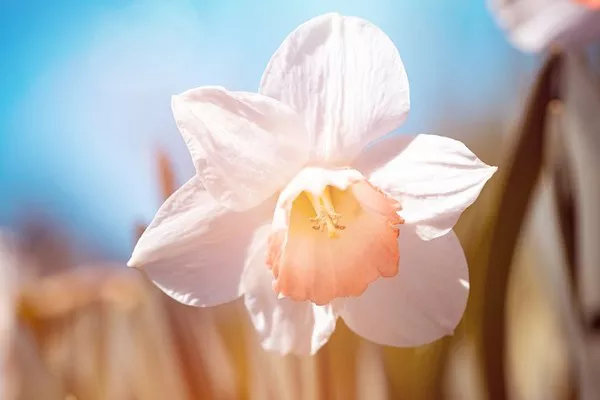The Narcissus flower, with its delicate and captivating appearance, has held a special place in human culture for centuries. Belonging to the Amaryllidaceae family, this perennial bulbous plant is renowned for its beauty, fragrance, and symbolic significance. Originating from the Mediterranean region, the Narcissus genus comprises numerous species and cultivars, each possessing unique characteristics and allure. From ancient mythology to modern literature, the Narcissus flower continues to evoke profound symbolism, reflecting themes of self-love, transformation, and rebirth. This essay aims to delve into the multifaceted symbolism of the Narcissus flower, explore its various types, and provide insights into its care and cultivation.
Types of Narcissus Flowers
The Narcissus genus encompasses a diverse array of species and cultivars, each distinguished by its distinct features and characteristics. Among the most notable types of Narcissus flowers are:
1. Narcissus poeticus: Also known as the Poet’s Narcissus or Pheasant’s Eye, this variety is celebrated for its pure white petals and a small yellow cup rimmed with red. It exudes a sweet fragrance and typically blooms in late spring.
2. Narcissus tazetta: Commonly referred to as the Tazetta Narcissus, this type features clusters of small, fragrant flowers with multiple blooms per stem. It is characterized by its rich golden-yellow hues and is often cultivated for its ornamental value.
3. Narcissus jonquilla: The Jonquil Narcissus is esteemed for its clusters of small, fragrant flowers and slender foliage. It boasts a delightful fragrance and is prized for its cheerful yellow blooms, which herald the arrival of spring.
4. Narcissus cyclamineus: With its distinctive swept-back petals resembling the wings of a butterfly, the Cyclamineus Narcissus is a charming variety that adds a touch of whimsy to gardens and landscapes. It features bright yellow blooms and blooms early in the spring season.
5. Narcissus ‘King Alfred’: This cultivar, often referred to as the King Alfred Daffodil, is renowned for its large, trumpet-shaped flowers and vibrant yellow coloration. It is a classic favorite among gardeners and is prized for its reliable performance and robust blooms.
Narcissus Flower Symbolism
The Narcissus flower has long been imbued with profound symbolism, encompassing a range of themes and interpretations across different cultures and epochs. One of the most enduring motifs associated with the Narcissus flower is that of self-love and introspection. In Greek mythology, the flower is intricately linked to the story of Narcissus, a handsome youth who became infatuated with his own reflection and ultimately transformed into the Narcissus flower. This mythological tale serves as a cautionary allegory about the perils of excessive self-absorption and vanity.
Moreover, the Narcissus flower symbolizes rebirth and renewal, as it emerges from the earth in the springtime, signaling the end of winter’s dormancy and the onset of new life. Its vibrant blooms and delicate fragrance evoke feelings of hope, optimism, and vitality, making it a potent emblem of rejuvenation and transformation.
Furthermore, the Narcissus flower is often associated with themes of resilience and endurance. Despite its delicate appearance, the flower is remarkably hardy and can thrive in a variety of conditions, symbolizing the power of inner strength and perseverance in the face of adversity.
In addition to its symbolic significance, the Narcissus flower holds cultural and religious connotations in various traditions around the world. In some cultures, it is revered as a symbol of good fortune, prosperity, and auspicious beginnings, often featured in festive celebrations and ceremonies.
How to Care for Narcissus Flowers
Caring for Narcissus flowers is relatively straightforward, requiring attention to a few key aspects to ensure optimal growth and blooming. Here are some essential tips for cultivating and nurturing Narcissus bulbs:
1. Planting: Narcissus bulbs should be planted in well-drained soil enriched with organic matter, preferably in the fall before the onset of winter. Choose a sunny or partially shaded location with adequate airflow to prevent fungal diseases.
2. Watering: While Narcissus bulbs require regular watering during their active growth phase, they are susceptible to rot if the soil becomes waterlogged. Water the bulbs thoroughly after planting and maintain moderate soil moisture throughout the growing season, allowing the soil to dry out slightly between waterings.
3. Fertilizing: Apply a balanced fertilizer formulated for bulbous plants in the spring when new growth emerges, following the manufacturer’s instructions for application rates and timing. Avoid over-fertilizing, as excessive nutrients can lead to lush foliage at the expense of flower production.
4. Mulching: Mulch the soil surface around Narcissus bulbs with a layer of organic mulch, such as shredded bark or compost, to conserve moisture, suppress weeds, and insulate the bulbs against temperature fluctuations. Mulching also helps maintain soil fertility and promotes healthy root development.
5. Deadheading: Remove spent flowers promptly to prevent the formation of seed pods, which can divert energy away from bulb development and future blooming. Snip off the faded blooms with sharp scissors or pruning shears, taking care not to damage the emerging foliage.
6. Division: Over time, Narcissus bulbs may become overcrowded and produce fewer flowers. To rejuvenate the planting and encourage vigorous growth, lift and divide the bulbs every three to five years after flowering has finished. Replant the divided bulbs at the appropriate depth and spacing, taking care not to damage the roots or foliage.
By following these guidelines for care and cultivation, gardeners can enjoy an abundance of beautiful Narcissus flowers year after year, enriching their outdoor spaces with their timeless beauty and symbolic resonance.
Conclusion
In conclusion, the Narcissus flower occupies a unique place in the realm of floral symbolism, embodying themes of self-love, renewal, and resilience. Its diverse array of species and cultivars captivates the imagination with their exquisite beauty and fragrance, enriching gardens and landscapes with their vibrant blooms. By understanding the profound symbolism of the Narcissus flower and cultivating it with care and reverence, individuals can forge a deeper connection to nature and the timeless cycles of life, death, and regeneration that it represents.


